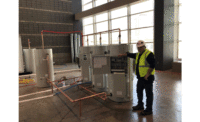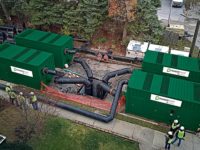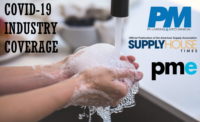The current state of the PVF industry is a challenging one, according to market experts.
On the distributor side, rising steel prices and supply chain disruption are causes for major concern.
“Right now steel prices are 30% to 40% higher than they were in December, and are continuing to climb as supply struggles to meet demand due to the pause in production months ago from the on-set of COVID-19,” says Gabe Hatfield, president of OK Pipe & Fittings. “Carbon Steel Pipe ERW is currently cheaper than seamless in most cases on stock sizes 14 inches and under, while stainless steel is getting more difficult to find. This is causing a price increase in fabricated fittings as well.”
OK Pipe & Fittings has reported quoting several large plant production projects across the U.S., but these projects have yet to be given the green light to proceed.
“Inquiries for 100% domestic make and melt are still present, which is a good sign for us,” Hatfield adds. “With the current difficulties of getting shipments from overseas, we will hopefully continue to see increased business for all local manufacturers.”
As for valves, most recently, sales are up as of the beginning of the year.
“Many manufacturers are still holding tight on dialing down their inventory,” notes Sara Alford, general manager of Newmans Valve and PVF Roundtable president. “This includes the big distributors such as MRC Global, DistributionNOW and Wolseley Industrial Group, just to name a few. Small and midsize distributors are holding tight on keeping inventory levels at a certain level to assist the big distributors with their shortages.”
Alford reports master distributors saw an increase in sales activity in February and are currently re-stocking from suppliers to meet demand. Quoting is strong in the PVF market and sales are sporadic, but increasing.
“Things have picked up on items where inventory started to get low at the end of 2020,” says Dan O’Neil, sales representative for H. A. O’Neil Co. “Some frac and drilling products are seeing signs of life. Our casting customers and repair facilities definitely have picked up since the new year, but there is still a long way to go to full recovery. Most general machine shops are still struggling to stay in business unless they have a specialty. I believe it will be a slow pickup until the third quarter. No one is predicting past then though because there are too many variables happening at once.”
The general consensus is that this year will better than 2020 but it will be tough to get back to 2019 sustainability and profits.
On the manufacturing end, while the residential market has been strong, the commercial sector has seen numerous project delays and cancellations.
Tom LaGuardia, vice president of sales and marketing for Milwaukee Valve, explains last March, as the country came to grips with the complexity and scale of the virus and its impact, business turned off almost immediately.
“We have manufacturing in China, so we had a few weeks of warning because our plants there had already been shut down and re-opened,” he notes. “We were having a great first quarter, and all of the sudden, volumes dropped. Orders just stopped. Many markets shut down completely and distributors didn’t need or want more inventory because of all the uncertainty.”
Greg Nahrgang, vice president of technical services and product development for Charlotte Pipe, refers to the PVF industry as a tale of two markets.
“The residential market, where we sell most of our plastic pipe and fittings, is robust, and we anticipate that it will remain strong throughout 2021,” he notes. “On the other hand, demand for our cast iron pipe and fittings, which primarily goes into commercial projects, pulled back in 2020. We were in a huge deficit through the first half of the year, but we were able to close the gap a bit in the second half. We are optimistic that the commercial construction momentum will continue through Q1 and Q2 2021.”
The pandemic has accelerated the plumbing industry to refine the focus on health and safety, and the PVF market is adapting, according to Joseph Welsh, Western regional sales manager, Leonard Valve Co.
“Manufacturers are aligning to the expanded needs in hands-free fixtures and safe water systems while adhering to code and standard changes,” he says. “This not only affects the way products are commercialized, but also what they are made of. A good example is ASSE 1070. ASSE 1070 addressed in both UPC and IPC codes for public handwashing. ASSE 1070 calls for the NSF 61 approval for low lead. This standard (NSF61) is much more stringent than the 2014 national low lead law. This has led some manufacturers to look into alternative materials to manufacture their valves to remain in compliance while adapting to the macro environment situation.”
Welsh notes that warm water has also become more important as the industry looks at hand washing because of the CDC recommendation of washing hands in warm water for a minimum of 20 seconds.
“As a result, warm water must be the right temperature and delivered to the user quickly,” he says. “This change has led to engineered designs to have fixtures closer to recirculated water. Mixing valves as a result must meet the demands and water flow must be efficient.”
Brian Jennings, vice president of industrial sales for Matco-Norca and SVF Flow Controls, says the PVF market appears to be stable and flat.
“We see some segments thriving, such as pharma and biotech, but others are suffering,” he explains. “Through all of this, we were still fortunate enough to grow our PVF business in 2020.”
Jennings notes everyone experienced a sharp drop off last spring, primarily in markets with more aggressive shutdowns. However, Matco-Norca and SVF Flow Controls have experienced growth in other regions of the U.S. to offset the losses.
“Increasing freight and material costs are recently becoming the biggest challenge,” he adds. “Also, virtual selling and remote customer engagement unfortunately continues to be a challenge; to cut through the email and virtual meeting noise we are all now dealing with, which we were not accustomed to before.”
Trends
Milwaukee Valve is focused on sorting through the “new rules” on how key market decision makers are doing business, according to LaGuardia.
“On March 10 2020, we took our 11 regional managers off the road and provided explicit direction to our rep network on things like customer visits (emergency situations only) and prospecting (phone and zoom calls only),” he says. “As the vaccine distribution spreads and businesses begin to open back up, we have to accommodate the new realities.”
There is also much interest and concern with how to safely recommission buildings that have sat vacant for months, Nahrgang explains.
“Many commercial buildings, particularly office buildings, have been idle as companies have been forced to have employees work from home,” he says. “Without any occupants, the mechanical and plumbing systems have not been used, and without frequent use and maintenance, many of these systems will suffer performance issues. As a simple example, if a plumbing fixture is not used for several months, it is quite possible for the p-trap to lose its seal which will then allow sewer gases to enter the building. There is also concern with water quality when the domestic water system is stagnant for a prolonged period of time.”
Jennings notes two major trends impacting the PVF market.
“First, there has been consolidation across all levels of the value chain,” he says. “There is consolidation and acquisition activity at the manufacturer, distributor and buying group levels of the supply chain. More than any time during our careers. Secondly, due to the financial pressures distributors are facing, they appear to be relying more on the manufacturers and master distributors for just in time inventory, as they don’t have the capital readily available to invest in local inventory at pre-COVID-19 levels. We have viewed this as an opportunity, and have heavily invested in our inventory by ramping up manufacturing and increasing our stock levels. I would anticipate both of these trends to continue into Q3 or Q4 of 2021. Rising material costs, freight costs and significant financial uncertainty still remains contributing to a volatile market.”
Connectivity also remains a large driver in the market.
“The ability to monitor and communicate with every part of your building is what the public wants,” Welsh notes. “Maintenance crews are looking for quick and simple ways to understand and diagnose the critical elements within their buildings. Building automation and monitoring of systems within a larger ecosystem will continue to grow through various communication protocols so that information can be readily available at all times. The industry is no different than what we see in other industries where Bluetooth technology, Wi-Fi and phone apps are appearing everywhere.
“The ‘not so secret’ secret in the commercial building market is that maintenance crews are shrinking and resources are at a premium,” he adds. “The facility staff at most colleges and universities are half of what they were just 10 short years ago. The same can be said in the health care and hospitality fields. Connectivity allows maintenance crews the ability to react faster and more efficiently. The trend is also allowing for information for ‘preventative’ type situations with proper monitoring. As an example, if your water heating source suddenly cools down by 50 degrees and an app notifies the building superintendent, it can be resolved often before the customer even becomes aware.”
Market outlook
The effects of COVID-19 will be felt in the PVF market for some time to come, notes Nahrgang, however, there is hope for the future.
“I foresee projects of all types having greater square footage as owners demand more space,” he says. “This will require more construction materials and more thoughtful design. The fundamentals for a strong single-family residential market, namely migration to the suburbs, low interest rates and pent up demand, lead me to believe that this market will remain strong for a few years. Eventually, the commercial projects that have been put on hold or canceled will come back on the boards. This will lead to a surge in commercial construction, and I think this could be a sustained surge. When construction comes to a halt in nearly every major metropolitan area in the country for several months, it eventually has to open back up, and when it does, there is going to be plenty of demand.”
Jennings expects the market to return to pre-COVID levels by the end of 2021, and hopes to get back to normal growth afterwards.
“Close distributor-manufacturer partnerships are more important now than ever,” he says. “I don’t remember a more challenging time in our industry than over the past 18 months navigating tariffs followed almost immediately by the pandemic. For SVF Flow Controls and Matco-Norca, being selectively aligned with strong PVF distributors is key to our success.”
Welsh is also optimistic as connectivity and technologies continue to evolve and adapt to various applications.
“It is a great time to be working within this dynamic industry,” he says. “There are technologies evolving and these technologies are being adopted more and more within various industries for use in building operations and water safety adherence. As time progresses, the intersection of health and safety combined with the technological advances will make our world a safer place for all, and I am excited to be a part of that.”
LaGuardia notes manufacturers have to be prepared for the ever-changing market conditions.
“A very successful launch to 2020 was shut down prematurely — those projects have not gone away, but nothing is guaranteed, either,” LaGuardia says. “The only guarantees are that, in the short-term, the current conditions are going to change dramatically. We need to get back on the road, back in front of our prospects, be that in person or by a Zoom call. Moving forward, forecasts and projects need to be confirmed. Is there really built-up demand? Hotel chains, schools and colleges and hospitals are all announcing new building and expansions. If that all happens, it speaks well to the long-term.
“The only thing that is 100% certain is no one in the industry has been through this before,” he adds. “Change is constant in business, and with 120 years under our belt, I’m confident Milwaukee Valve will adjust. As an industry, we should be proud of what we have accomplished collectively. The services we provide are mission-critical and the specifications, installations and products need to perform for long periods of time. No pandemic, administration change or Zoom call will ever change that. It is nice to have that constant in our industry. No matter the volume, these services need to be handled.”










